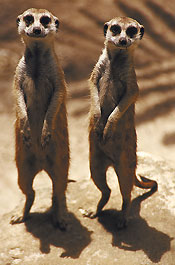Cooperative Breeding in Meerkats
Biology 342 Fall 08
Daniel Bernstein and Justine Spencer
Adaptive Value
Why co-operate? What value does this have over evolutionary time?
Success in Numbers
Belonging to a group is necessary to survive the harsh environment in which Meerkats live. They huddle together for warmth, dig burrows together, and groom each other. They take turns on sentry duty, without which Meerkats could not feed safely. Group sizes are large to achieve the necessary strength to defend their territory. Meerkats must co-operate to achieve and sustain the success of the group, whereas individually this is not possible. Individual prospects for survival and reproduction rely on the survival and prosperity of the group as a whole.
Meerkats cannot produce offspring without the help of the group. An individual Meerkat simply cannot find enough food and protection to safely raise offspring. The group raises the young collectively, by feeding and protecting the young. As a result, pup survival increases with group size (Clutton-Brock et al, 2001).
However, there is a catch. Resources are too limited to care for the young of all females who become pregnant. The number of offspring must be controlled so that the young can be successfully reared into healthy adults. This means there is competition among females for who becomes pregnant. If the competition fails to reduce the number of offspring, infanticide is common (Young & Clutton-Brock, 2006).

Photo courtesy of nationalgeographic.com
Not Simple Altruism
Females are more likely than males to breed within their natal group. This is probably because females receive a direct benefit by way of cooperative breeding and the aid of helpers in rearing the pup. (Clutton-Brock et al, “evolution and development of sex differences in co-operative behavior in Meerkats). However, helpers are not simply altruistic. These helpers have a significant and positive influence on the chances the offspring will be reproductively successful. This is because helpers both reduce the age the offspring can begin to reproduce, and increase the probability they will achieve alpha rank (Russell et al, 2007). Increased numbers of helpers leads to an increase of body weight, increased foraging skills, and thus increased survival rates in the first year of life. Helpers also gain benefits from helping to rear the young: if the young they rear develop good foraging skills, at independence they will be better helpers in rearing the subsequent young, thus making less work for the previous helpers (Clutton-Brock et al, 2001).

Photo courtesy of nationalzoo.si.edu
Reproductive Potential
In females only, pups that are raised well by helpers are more likely to breed at a younger age as subordinates, and have a better chance of competing for alpha rank. This is because of the advantage they have by maintaining a good weight during rearing. An individual’s reproductive potential during adulthood is size-dependent, and that advantage begins before independence, and lasts into adulthood (Clutton-Brock et al, 2006), to be passed onto the next generations.